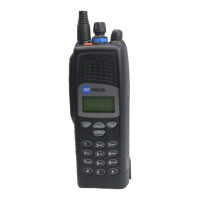144 Interface Fault Finding TP9100 Service Manual
© Tait Electronics Limited May 2005
Task 6 —
Status LED Faulty
Use this procedure if the status LED is not operating according to
Table 4.10 on page 98. For example, the red LED does not operate when
the radio is transmitting, or the green LED does not operate when the radio
is receiving. Before proceeding make sure the fault is not transmitter or
receiver related. See “Check the Transmit and Transmit-Audio Functions”
on page 132 and “Check the Receive and Receive-Audio Functions” on
page 133.
If the status LED is faulty:
1. Remove the front panel and the main shield assembly.
2. Connect a multimeter or oscilloscope to pin A1 (green LED) or pin
A2 (red LED) of DS900. See Figure 7.2.
3. Activate the relevant LED. For the green LED, feed a signal without
modulation on the receive channel. For the red LED, ensure the
antenna port is terminated with a 50
Ω load or antenna, and
temporarily place the radio in transmit mode.
Important Do not transmit for more than five seconds with the main
board removed from the chassis.
4. As the LED is activated, monitor the voltage on the appropriate pin.
The voltage should be as follows:
5. If the voltage levels are not correct proceed to Step 6. If they are
correct, proceed to Step 7.
6. Replace Q904, and R932 (red LED faulty) and/or R935 (green LED
faulty). Retest the LED. If the LED is still faulty, proceed to Step 7.
7. Replace DS900, and R921 (red LED faulty) and/or R920 (green
LED faulty). Retest the LED.
8. If the LED is still faulty, replace the main board.
green LED: pin A1
red LED: pin A2
LED inactive: <1V
LED active: >3V

